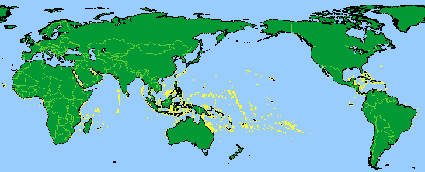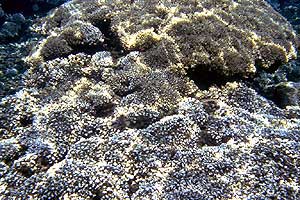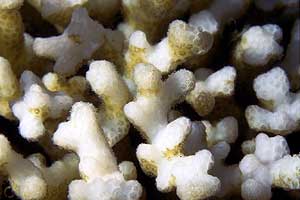
 Hydrosphere
Hydrosphere
Coral reefs thrive in clear tropical and semitropical ocean water. Most
coral species require temperatures between 18 and 30 degrees Celsius. If
the water temperature moves outside the range for long periods, the coral
will be harmed, and the coral polyps might die. The coral living the
farthest north are located in the Mediterranean Sea and in the western
Pacific Ocean. Map: This shows the location of coral reefs around the world.
For an interactive version of this map, please visit
http://reefgis.reefbase.org/mapper.asp. Map data courtesy of Reef Base by the World Conservation Monitoring Centre in Cambridge, UK.
Coral Bleaching
When ocean temperatures increase, coral bleaching (loss of zooxanthellae algae) occurs. The coral turn white and dies. Coral bleaching happens when the zooxanthellae algae are expelled from the coral polyps. The algae allow photosynthesis to occur and for the coral and other organisms to grow. When the algae go, the coral then take on a white color, or bleached appearance.
 Photo: Bleached and normally pigmented Pocillopora colonies mix on a coral reef in the Gulf of Panama. Photo courtesy of NOAA. |
 Photo: Here is partially bleached Pocillopora damicornis from a coral reef in the Gulf of Panama. Photo courtesy of NOAA. |
Although coral can recover after a bleaching episode, the coral often die after bleaching.
The causes of bleaching are uncertain, but they seem to be related to other events occurring in the Earth system. El Nino, which results in warmer than normal ocean temperatures, appears to be a major factor. Global warming and increased ultraviolet radiation because of ozone depletion have also been investigated as possible causes or contributing factors to coral bleaching.
Major bleaching events occurred in 1982-1983, 1987, and 1995-1996. The 1995-1996 event began in the western Caribbean and then spread to the west and central Pacific in 1996. The 1982-1983 and 1987 events coincided with El Ninos. According to testimony before the U.S. Senate in 1991, short-term warming events caused the major bleaching.
A warming of 1 degree to 2 degrees C appears enough to stress the coral and result in bleaching. Apparently, as in the case of one Mediterranean coral, increased water temperature can lower the coral's resistance to bacterial infections. One encouraging factor is that when temperatures return to normal, the zooxanthellae return to the coral.
Coral reefs also require the ocean water to have low levels of nutrients like nitrogen and phosphorous and certain levels of salinity (salt) and carbonate (ions made of carbon and oxygen). Some scientists fear that increased carbon dioxide dissolved in the ocean removes the carbonate. That makes less available for the coral to produce limestone—the basic building block of coral reefs. Carbon dioxide forms a weak acid in water that holds the carbonate ions, preventing the coral from using them.
Anthrosphere | Atmosphere | Biosphere | Hydrosphere | Lithosphere
Glossary ..|.. Related Links ..|.. References |..PBL Model
Home ..|.. Teacher Pages ..|.. Modules & Activities
Maintained by ETE Team
Last updated
April 22, 2004
Privacy Statement and Copyright © 1997-2004 by Wheeling Jesuit University/NASA-supported Classroom of the Future. All rights reserved.
Exploring the Environment®, Coral Reefs was developed under a cooperative agreement with NASA.
Some images © 2004 www.clipart.com
Center for Educational Technologies, Circuit Board/Apple graphic logo, and COTF Classroom of the Future logo are registered trademarks of Wheeling Jesuit University.